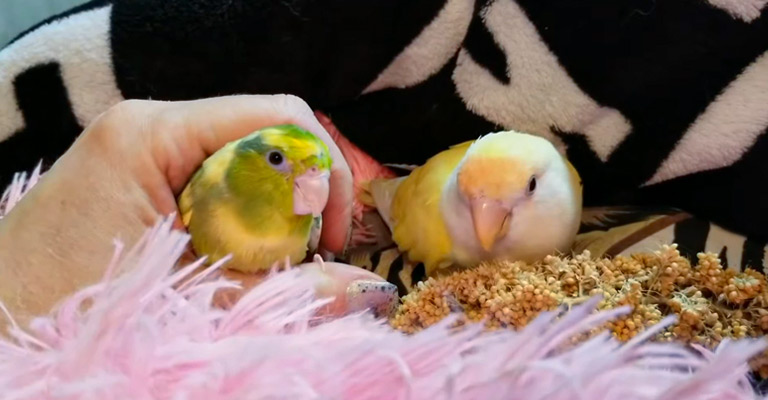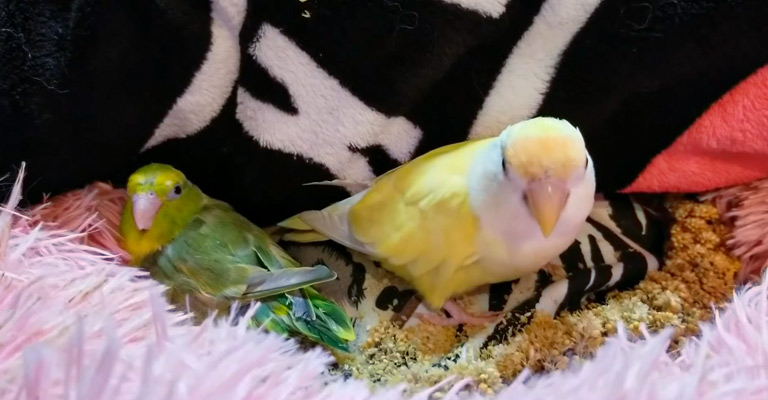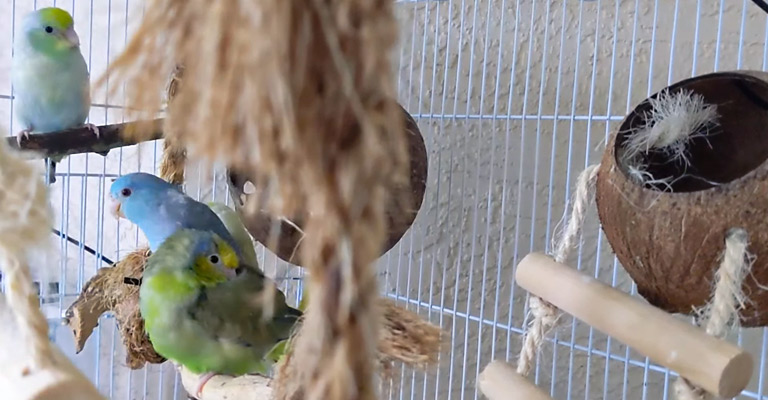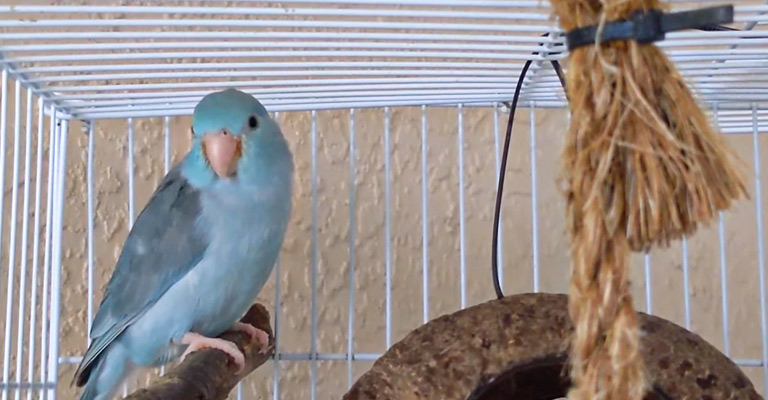Parrotlets, with their vibrant plumage and charismatic personalities, have a special place in the hearts of bird enthusiasts. These petite parrots are known for their social nature, but when it comes to sharing their living space with other feathered friends, a careful approach is essential.
In this blog post, we’ll explore the fascinating world of avian companionship and answer the question: What birds can parrotlets live together with?
While parrotlets can thrive as solitary pets, introducing them to compatible bird companions can enhance their quality of life. However, choosing the right feathered friend requires a deep understanding of parrotlet behavior, species compatibility, and diligent oversight during the introduction process.
Join us on this journey to discover which avian companions can make feathered harmony with parrotlets, and learn valuable insights into creating a joyful, multi-bird household.

Can Parrotlets Live Together With Any Bird?
Parrotlets are small, social birds known for their charming personalities, but not all birds make suitable companions for them. When considering housing parrotlets with other birds, it’s crucial to prioritize their safety and well-being.
Parrotlets can often live harmoniously with other small, non-aggressive bird species of similar size, temperament, and dietary needs. Examples include budgerigars, canaries, and finches. However, introducing birds of different species requires careful supervision to prevent conflicts.
Avoid housing parrotlets with larger, more dominant birds or those known for aggression, such as parakeets, lovebirds, or larger parrots. These pairings may result in stress, injury, or even death for the parrotlets.
Always monitor their interactions and provide ample space, separate feeding stations, and enrichment to prevent territorial disputes.
While parrotlets can coexist with certain bird species, compatibility depends on individual temperament and careful management to ensure their safety and happiness.
Factors to Consider When Choosing Companion Birds for a Parrot

Choosing companion birds for a parrot is a decision that should be made thoughtfully, as it can significantly impact the well-being and happiness of both the parrot and the new feathered friend. Here are several important factors to consider:
Species Compatibility
Not all birds get along with each other. Research the temperament, size, and social behavior of potential companion birds to ensure they are compatible with parrots. Generally, smaller, non-aggressive species tend to be better choices.
Size Match
It’s essential to choose a companion bird of a similar size to your parrot. A bird that’s significantly larger or smaller may intimidate or be intimidated by your parrot, leading to stress or aggression.
Social Needs
Parrots are highly social creatures and benefit from companionship. Look for bird species that are known to be social and enjoy interacting with other birds. Avoid solitary or aggressive species.
Dietary Compatibility
Ensure that the dietary requirements of both birds are similar. This simplifies feeding and ensures that each bird gets the proper nutrition. Consult with an avian veterinarian for advice on feeding multiple bird species.
Age and Gender
Consider the age and gender of both birds. Younger birds tend to adapt more easily to new companions. Pairing birds of the same gender can help prevent breeding behaviors and potential conflicts over nesting sites.
Quarantine and Health Checks
Before introducing a new bird to your parrot, quarantine them in a separate area for at least 30 days. This helps prevent the spread of diseases. Ensure both birds have been thoroughly checked by an avian veterinarian to rule out any health issues.
Cage Size and Layout
Make sure your birdcage is large enough to accommodate both birds comfortably, with separate feeding and water stations. The cage should also have plenty of perches, toys, and hiding spots to reduce territorial disputes.
Supervision and Introduction
Monitor the initial interactions closely. Birds may need time to adjust to each other’s presence. Gradual introductions in a neutral territory can help reduce stress and aggression.
Enrichment and Social Time
Provide mental and physical stimulation through toys, puzzles, and out-of-cage playtime for both birds. Interaction with you is also essential to prevent feelings of neglect.
Escape Routes
Ensure that both birds have escape routes in case of conflicts. Multiple perches and hiding spots can help reduce stress during confrontations.
Consult an Expert
Seek advice from an avian behaviorist or an experienced bird owner if you’re unsure about compatibility or are encountering behavioral issues between your parrot and its companion.
Remember that every bird has a unique personality, so there are no guarantees of a perfect match. Some parrots may prefer to be the only bird in the household and may not tolerate a companion.
Always prioritize the safety, health, and happiness of your birds when making companion choices, and be prepared to make adjustments if necessary to ensure a harmonious living arrangement.
Suitable Companion Birds for Parrotlets

When selecting suitable companion birds for parrots, it’s important to consider their social needs, size, and compatibility to ensure a harmonious living arrangement.
Here are some bird species that are generally considered good companions for parrots:
Budgerigars (Budgies)
Budgerigars are small, sociable birds that can get along well with parrots. They have friendly personalities and enjoy interacting with other birds. Their small size makes them a less intimidating companion.
Cockatiels
Cockatiels are slightly larger than budgies and have gentle, friendly dispositions. They often form strong bonds with parrots and can share a cage or living space successfully.
Lovebirds
Lovebirds are similar in size to cockatiels and are known for their affectionate nature. While they can be territorial, they can coexist with parrots if introduced gradually and provided with ample space.
Canaries and Finches
Canaries and finches are small, peaceful birds that usually pose little threat to parrots. They can cohabitate in an aviary or a large cage, and their colorful plumage can add vibrancy to the environment.
Conures
Some conure species, such as the Green-cheeked Conure, are of similar size and temperament to parrots. They are playful and can form close bonds with parrot companions.
Senegal Parrots
Senegal parrots are known for their gentle and friendly nature. They are similar in size to many parrot species and can make good companions if introduced properly.
Poicephalus Parrots
Certain Poicephalus parrots, like the Meyer’s Parrot or the Senegal Parrot, can be suitable companions for other parrots due to their similar size and social behavior.
Quakers (Monk Parakeets)
Quaker parrots are small and sociable birds that can get along well with parrots. They are playful and enjoy social interaction.
Caiques
Caiques are energetic and playful birds that can be compatible with certain parrot species. They enjoy physical activity and can provide entertainment for parrots.
Eclectus Parrots
Eclectus parrots are known for their calm and friendly demeanor. They are often compatible with other parrot species when introduced gradually.
Remember that individual personalities and temperaments can vary among birds of the same species, so it’s essential to monitor their interactions closely when introducing new companions. Additionally, providing ample space, enrichment, and social interaction for all birds is crucial for their well-being.
Consulting with an avian veterinarian or an experienced bird behaviorist can also offer valuable guidance when selecting and introducing companion birds for your parrot.
Birds to Avoid as Companions of a Parrot

While some bird species can make suitable companions for parrots, there are several bird species that you should generally avoid as companions due to differences in size, temperament, or behavior.
Here are some birds to avoid as companions for parrots:
Larger Parrot Species
Avoid housing smaller parrots like parrotlets, lovebirds, or budgerigars with larger parrot species such as macaws, cockatoos, or African greys. Larger parrots may pose a physical threat to smaller birds.
Aggressive Species
Birds known for their aggression, territorial behavior, or bullying tendencies should be avoided. This includes birds like aggressive parakeets (e.g., Indian Ringnecks), mynas, and aggressive finch species.
Cockatoos
Cockatoos, while charming and affectionate, can be demanding and noisy. Their social needs may not align with those of many other parrot species, leading to stress and conflict.
Aggressive Parakeets
Some parakeet species, like the Monk Parakeet (Quaker parrot), can be territorial and may not coexist peacefully with parrots.
Aggressive Lovebird Species
Certain lovebird species, like the Peach-faced Lovebird, can be territorial and possessive, making them incompatible with parrots.
Canaries and Finches with Long Tails
Birds with long tail feathers, such as some canaries and finches, can become targets for harassment or aggression from parrots who may try to pull or chew their tails.
Nesting Birds
Birds that are actively breeding or nesting should not be housed with parrots, as this can lead to territorial disputes and aggression.
Sick or Injured Birds
Avoid introducing sick, injured, or weak birds to a parrot’s environment, as they may be vulnerable to aggression and may spread disease.
Wild-Caught Birds
Wild-caught birds may carry diseases and may not be well-suited for living with domestically bred parrots. They can also have difficulty adapting to captivity.
Unfamiliar Species
Introducing birds of unfamiliar species without proper research and supervision can lead to unexpected conflicts and stress.
Always prioritize the safety and well-being of your parrot when considering companion birds. If you’re unsure about compatibility or if you encounter behavioral issues, consult with an avian veterinarian or an experienced bird behaviorist for guidance.
Proper introductions, ample space, and careful monitoring are crucial when introducing any new bird to your parrot’s environment to ensure a peaceful coexistence.
Tips on Introducing Birds to Each Other
Introducing birds to each other can be a delicate process, as it involves minimizing stress and potential conflicts. Whether you’re introducing birds of the same species or different species, here are some tips to help ensure a smooth introduction:
Quarantine
Before introducing a new bird to your existing flock, quarantine the newcomer in a separate room or enclosure for at least 30 days. This helps prevent the spread of diseases and allows you to monitor the health of the new bird.
Gradual Introduction
When you’re ready to introduce the birds, do so gradually. Start by placing their cages near each other but with enough distance to prevent direct contact. Allow them to become accustomed to each other’s presence.
Neutral Territory
Choose a neutral territory for the first face-to-face meeting. This could be a neutral room or an area where neither bird has established territory. Avoid placing them in an existing bird’s cage initially.
Supervision
Always supervise the initial interactions closely. Be prepared to intervene if any aggressive behavior or signs of stress occur. Keep a towel or a thick glove nearby in case you need to separate birds quickly.
Positive Reinforcement
Reward positive interactions with treats and praise. Offer treats to both birds when they are calm and not displaying aggression. This can help create positive associations.
Separate Feeding and Water
During the introduction phase, provide separate feeding and water stations to avoid competition and territorial disputes. Gradually move them closer over time.
Observe Body Language
Pay close attention to the body language of both birds. Signs of aggression may include raised feathers, hissing, lunging, or biting. If you notice these signs, separate the birds and try again later.
Physical Separation
If conflicts persist, you may need to physically separate the birds in their respective cages while they continue to adjust to each other’s presence. Gradually increase their time together as they become more tolerant.
Size and Compatibility
Ensure that the birds you’re introducing are of similar size and temperament. Some birds may not be compatible due to personality differences.
Patience
Introducing birds can take time, sometimes weeks or even months. Be patient and allow the birds to establish their own pecking order and boundaries.
Consult an Expert
If you encounter persistent aggression or other issues during the introduction process, seek guidance from an avian veterinarian or a professional bird behaviorist who can provide personalized advice.
Separate Sleeping Quarters
In the initial stages, consider keeping the birds in separate cages at night to reduce stress and the likelihood of nighttime conflicts.
Remember that not all birds will get along, and some may be best kept as solitary pets. The key is to prioritize the safety and well-being of all the birds involved and to allow them the time they need to adjust to each other’s presence.
Potential Challenges Regarding a Parrot’s Companion
Introducing a companion to a parrot can be a rewarding experience, but it’s important to be aware of potential challenges that can arise during this process. Here are some common challenges you may encounter when introducing a companion to your parrot:
Aggression
One of the most significant challenges is aggression between the parrot and its new companion. This can involve territorial behavior, biting, and physical attacks. It may take time for them to establish a hierarchy and learn to coexist peacefully.
Stress
The introduction of a new companion can be stressful for both birds. Parrots are territorial by nature, and the presence of another bird in their space can cause anxiety. Stress can lead to health problems, so it’s crucial to monitor their well-being during this period.
Jealousy
Parrots can be possessive and may exhibit jealousy when they see you interacting with the new companion. This can result in aggressive behavior or attempts to exclude the other bird.
Health Concerns
Introducing a new bird into your home carries the risk of disease transmission. Even if the new bird appears healthy, it could be a carrier of infectious diseases that may affect your parrot.
Compatibility Issues
Not all parrots are social or interested in having a companion. Some parrots are naturally solitary and may not accept a new bird in their environment. Compatibility issues can lead to constant stress and conflicts.
Bonding Challenges
If your parrot has a strong bond with you, it may resist forming a bond with the new companion. This can make it difficult for the two birds to interact and share their space.
Territorial Disputes
Parrots can be territorial about their cages, perches, and favorite spots. When introducing a new companion, these territorial disputes can lead to conflicts and competition.
Time and Patience
Building a positive relationship between your parrot and its new companion can be time-consuming. It requires patience, supervision, and consistent effort.
Separate Care Needs
Different bird species or individual birds may have varying care requirements, including diet, exercise, and social interaction. Balancing the needs of both birds can be a challenge.
Separate Cages
In some cases, it may be necessary to keep the parrot and its companion in separate cages due to ongoing conflicts. This can be an added expense and logistical challenge.
To overcome these challenges, it’s essential to do thorough research and preparation before introducing a companion to your parrot. Consult with an avian veterinarian or a professional bird behaviorist for guidance and advice specific to your situation.
Always prioritize the health, safety, and well-being of your birds, and be prepared to adapt your approach as needed to ensure a harmonious living arrangement.
FAQs
Yes, Parrotlets can coexist with other parrot species, but compatibility varies. Similar-sized parrots with compatible temperaments, such as budgerigars, lovebirds, and some conures, often make suitable companions. Careful supervision and gradual introductions are key to success.
Yes, Parrotlets can generally live peacefully with smaller, non-aggressive birds like finches and canaries. Their size and temperament differences often result in minimal conflicts. Ensure adequate cage space and monitor interactions for safety.
Parrotlets should avoid living with larger, more dominant parrot species, aggressive parakeets, and territorial birds. These pairings can lead to stress, aggression, or even harm to the Parrotlets.
Parrotlets can sometimes live harmoniously with doves or pigeons, as these birds tend to be calm and non-confrontational. Ensure they have adequate space, separate feeding stations, and monitor their interactions.
Parrotlets are social birds and can benefit from companionship. While they can live alone, introducing a compatible bird companion can enhance their well-being, as long as you follow proper introduction and care guidelines.
Wrapping Up
In the world of avian companionship, pairing parrotlets with the right feathered friend can be a rewarding experience. From the chirpy melodies of budgerigars to the gentle coexistence with doves, the choices are diverse.
Yet, it’s crucial to remember that every bird, just like humans, has its unique personality, and compatibility can vary.
Ultimately, the key to a harmonious avian household lies in careful consideration, patient introductions, and ongoing observation.
Whether you decide to let your parrotlet share its space with a fellow parrot or a non-parrot species, the bond that forms between these colorful characters is sure to bring joy to your aviary.
So, with knowledge in hand, embark on this feathered journey and create a haven of harmony for your parrotlet and its newfound friend. Thank you for your time.